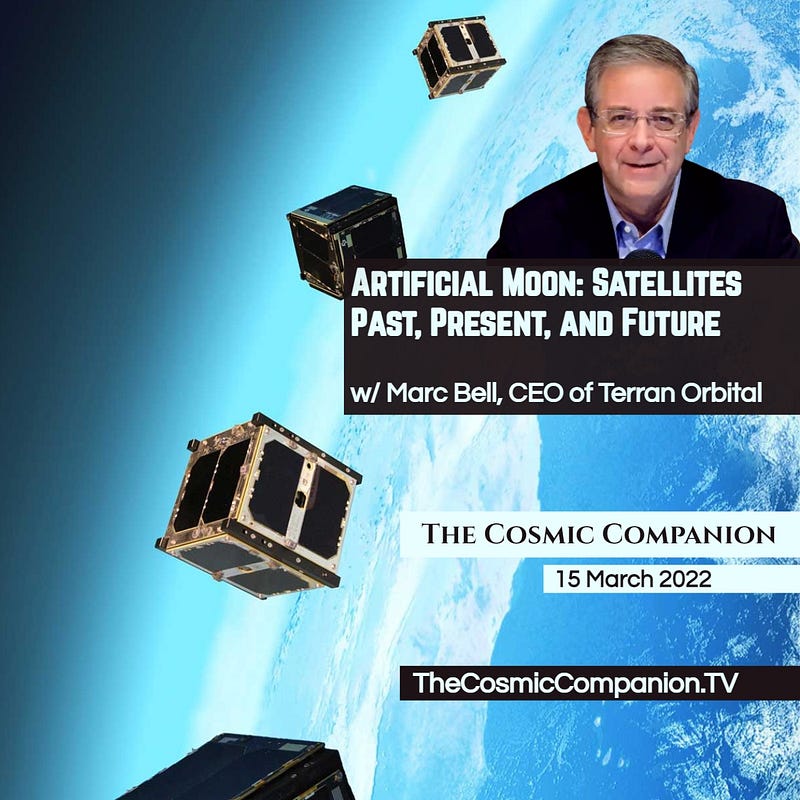Exploring Satellites: From the Cold War to Future Outposts
Written on
Chapter 1: The Dawn of Satellites
In this episode of The Cosmic Companion, we delve into the world of satellites—artificial moons that orbit not only Earth but other celestial bodies as well. We’ll trace the journey of these remarkable devices, discussing their historical significance and how they have become integral to our daily lives. Additionally, we will have a conversation with Marc Bell, CEO of Terran Orbital, focusing on the advancements in SmallSat technology and the horizon of satellite innovations.

Section 1.1: A Look Back in Time
The year 1957 was notable not just for its popular Western TV series but also for monumental events in space exploration. During this era, the concept of an artificial moon seemed confined to the realms of science fiction. The Cold War fueled a fierce competition between the United States and the Soviet Union to achieve significant milestones in space.
On October 4, 1957, the launch of Sputnik shocked the world and marked a pivotal moment in history. This unexpected success showcased the Soviet Union's technological capabilities, prompting a swift response from the U.S. government. Under President Eisenhower's directive, Explorer 1 was launched on January 31, 1958, marking the United States' first major achievement in space. This mission not only surpassed Sputnik in altitude but also outlasted it, serving as the first space observatory to study both Earth and the Sun.
Section 1.2: The Rise of Communication and Observation Satellites
Just a few months later, the launch of Telstar 1 on July 10, 1962, heralded the era of communication satellites, while TIROS-1, launched on April 1, 1960, became the first weather satellite, a joint effort by NASA and NOAA. The landscape of satellite technology continued to evolve, leading to the creation of the first X-ray telescope, Uhuru, which was launched in late 1970 to observe cosmic phenomena.
Chapter 2: The Current Satellite Landscape
As of 2021, approximately 6,500 satellites were documented orbiting Earth, with only a little over half actively functioning. The majority of these active satellites serve communication purposes, while others focus on Earth observation, technological experiments, and astronomy. However, the presence of defunct satellites poses challenges for both robotic and human missions, creating risks amidst the increasing amount of space debris.
The first video, "Artificial Moon: Satellites Past, Present, and Future," featuring Marc Bell, offers a comprehensive overview of the evolution and future of satellite technology.
The second video, "Lunar Exploration Past, Present and Future," provides insights into how satellites will play a crucial role in future lunar missions.
Section 2.1: The Future of Satellite Technology
In our modern era, satellites have become indispensable, powering communication, navigation, and scientific exploration. The advent of SmallSats—compact satellites smaller than a refrigerator—has revolutionized the field, with CubeSats being a particularly notable example.
As humanity extends its reach into the cosmos, satellites will be vital for operations on the Moon and Mars, facilitating communication, observation, and logistics for settlers. In the early stages of interplanetary colonization, regular supply missions from Earth will rely heavily on satellite guidance, ensuring the success and safety of these missions.
James Maynard, founder and publisher of The Cosmic Companion, has a rich background in space exploration and resides in Tucson with his family and pets.
Did you find this article interesting? Subscribe to The Cosmic Companion for more insightful content and join us for our podcast and weekly video series!